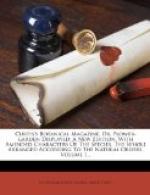It is only in very favourable situations that these shrubs ripen their seeds in England, hence they are most commonly propagated by layers, which readily strike root: MILLER says, that the plants raised from seeds are hardier than those produced from layers.
It thrives best in sheltered situations and a dry soil.
[39]
Franklin’s Tartar.
A Scarlet Bizarre Carnation.
[Illustration: No 39]
The Carnation here exhibited is a seedling raised by Mr. FRANKLIN, of Lambeth-Marsh, an ingenious cultivator of these flowers, whose name it bears: we have not figured it as the most perfect flower of the kind, either in form or size, but as being a very fine specimen of the sort, and one whose form and colours it is in the power of the artist pretty exactly to imitate.
The Dianthus Caryophyllus or wild Clove is generally considered as the parent of the Carnation, and may be found, if not in its wild state, at least single, on the walls of Rochester Castle, where it has been long known to flourish, and where it produces two varieties in point of colour, the pale and deep red.
Flowers which are cultivated from age to age are continually producing new varieties, hence there is no standard as to name, beauty, or perfection, amongst them, but what is perpetually fluctuating; thus the red Hulo, the blue Hulo, the greatest Granado, with several others celebrated in the time of PARKINSON, have long since been consigned to oblivion; and it is probable, that the variety now exhibited, may, in a few years, share a similar fate; for it would be vanity in us to suppose, that the Carnation, by assiduous culture, may not, in the eye of the Florist, be yet considerably improved.
To succeed in the culture of the Carnation, we must advert to the situation in which it is found wild, and this is observed to be dry and elevated; hence excessive moisture is found to be one of the greatest enemies this plant has to encounter; and, on this account, it is found to succeed better, when planted in a pot, than in the open border; because in the former, any superfluous moisture readily drains off; but, in guarding against too much wet, we must be careful to avoid the opposite extreme.
To keep any plant in a state of great luxuriance, it is necessary that the soil in which it grows be rich; hence a mixture of light-loam, and perfectly rotten horse or cow dung, in equal proportions, is found to be a proper compost for the Carnation. Care should be taken that no worms, grubs, or other insects, be introduced with the dung; to prevent this, the dung, when sifted fine, should be exposed to the rays of the sun, on a hot summer’s day, till perfectly dry, and then put by in a box for use; still more to increase the luxuriance of the plants, water it in the spring and summer with an infusion of sheep’s dung.




